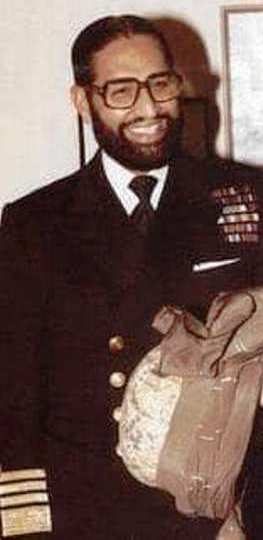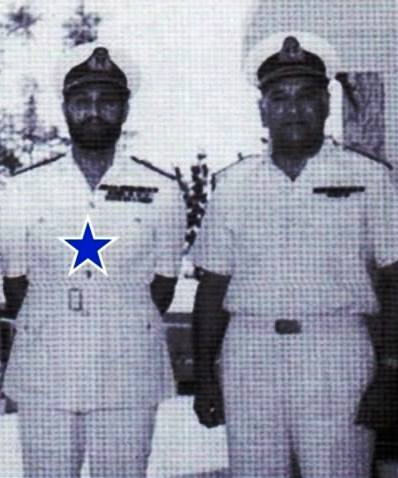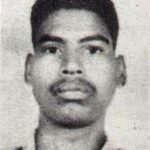Admiral Mohammad Shariff Age, Death, Wife, Children, Family, Biography & More
| Bio/Wiki | |
|---|---|
| Profession | Retired Pakistan Navy Officer |
| Famous for | Being the Flag Officer Commanding (FOC) of the Eastern Naval Command in East Pakistan during the 1971 war |
| Military Service | |
| Service/Branch | • Royal Indian Navy (1936 - 1947) • Pakistan Navy (1947 - 1980) |
| Rank | Admiral |
| Service Years | 1936 - 1980 |
| Command | Flag Officer Commanding (FOC) Eastern Naval Command (1969 - 16 December 1971) |
| Designations (major ones) | • Deputy Chief of Naval Staff (DCNS) (Personnel) (1962) • Deputy Chief of Naval Staff (DCNS) (Operations) (1966) • Vice-Chief of Naval Staff (VCNS) (1974) • Chief of Naval Staff (CNS) (8 March 1975 - 1978) • 2nd Chairman of the Joint Chiefs of Staff Committee (CJCSC) (1977 - 1980) |
| Military Decorations | Pakistani Decorations • Pakistan Tamgha from the Government of Pakistan after the partition • Tamgha-e-Jamhuria from the Pakistani government (1956) • Sitara-e-Harb by the Government of Pakistan for the 1965 Indo-Pakistan War • Pakistan’s second-highest military award Hilal-e-Jurat for the 1971 War by the Pakistani government • Sitara-e-Harb by the Pakistani government for the 1971 Indo-Pakistan War • Tamgha-e-Jang by the Pakistani government for the 1971 Indo-Pakistan War • Tamgha-e-Diffa by the Pakistani government for the 1971 Indo-Pakistan War • Nishan-e-Imtiaz (Military) by Prime Minister Zulfiqar Ali Bhutto after repatriation from India in March 1973 • Tamgha-e-Sad Saala Jashan-e-Wiladat-e-Quaid-e-Azam by the Government of Pakistan (1976) • Hijri Tamgha by the Pakistani government (1979) British Decorations • 1939-1945 Star • Africa Star • Atlantic Star • War Medal 1939-1945 • India Service Medal 1939–1945 • Queen Elizabeth II Coronation Medal (1953) American Decoration • The Legion of Merit (Degree of Commander) by the Government of the United States of America |
| Personal Life | |
| Date of Birth | 1 July 1920 (Thursday) |
| Birthplace | Gujrat (a city in Pakistan), Punjab Province, British India (now in Punjab Province, Pakistan) |
| Date of Death | 27 April 2020 |
| Place of Death | Islamabad |
| Age (at the time of death) | 99 Years |
| Death Cause | Natural causes [1]The Express Tribune |
| Zodiac sign | Cancer |
| Nationality | British Indian (1920 - 1947) Pakistani (1947 - 2020) |
| Hometown | Gujrat, Punjab Province, Pakistan |
| School | Rashtriya Indian Military College (RIMC), Dehradun, India |
| College/University | Naval War College, Newport, Rhode Island, US |
| Educational Qualification | A master's degree in War Studies (1962) [2]Naval War College Review |
| Religion | Islam [3]War in the Indian Ocean by Mihir K. Roy – Google Books |
| Ethnicity | Punjabi-Kashmiri [4]Ilmi Encyclopaedia of General Knowledge by Ilmi Kitab Khana – Google Books |
| Relationships & More | |
| Marital Status (at the time of death) | Not known |
| Family | |
| Wife/Spouse | Not known |
Some Lesser Known Facts About Mohammad Shariff
- Mohammad Shariff served as the Flag Officer Commanding (FOC) of the Pakistan Navy’s Eastern Command in East Pakistan (now Bangladesh) during the 1971 Indo-Pakistan War. He died due to natural causes at the age of 99 in Islamabad on 27 November 2020.
- In 1936, Shariff joined the Royal Indian Navy (RIN) as a sailor. During the Second World War, he served with the RIN as a Signalist and participated in the Battle of the Atlantic, the East African campaign, the South-East Asian theatre, and the Battle of the Mediterranean.
- In 1945, he was sent to the Britannia Royal Naval College (BRNC) after he applied for an officer’s commission in the RIN. He was commissioned as a Sub-Lieutenant after graduating from the BRNC with a Staff Course degree in 1946. Later, he participated in the mutiny against the British officers serving in the Royal Indian Navy.
- In 1947, after the partition of India, Shariff joined the Pakistan Navy. At the time of his joining, he had become a Lieutenant. He was the 20th most senior officer of the Pakistan Navy according to the list given by the RIN to the Government of Pakistan.
- From 1953 to 1956, as a Lieutenant Commander, Shariff was posted to the Naval Headquarters in Karachi as a Senior Staff Officer.
- In 1960, Shariff was elevated to the rank of Commander.
- He was promoted and made a Captain (equivalent to a Colonel in the army) and was posted as Deputy Chief of Naval Staff (Personnel) after he returned to Pakistan from the US, where he attended a course at the Naval War College in 1962.
- During the 1965 war with India, Sharif continued to serve as Deputy Chief of Naval Staff (Personnel). He played an instrumental role in planning several coordinated attacks on the Indian Navy during the war.
- In 1966, he was promoted to the rank of Commodore and posted as the Deputy Chief of Naval Staff (DCNS) (Operations). He served as a DCNS (Operations) till 1969 under the command of Vice-Admiral Syed Mohammad Ahsan.
- In 1968, leading a delegation of high-ranking military officials, Shariff visited China and held military talks with the senior commanders of the People’s Liberation Army (PLA).
- In 1969, after getting promoted to the rank of Rear-Admiral, Shariff was sent to assume the command of the Pakistan Navy’s Eastern Command as Flag Officer Commanding (FOC) in East Pakistan (now Bangladesh). The Pakistan Navy conducted several military exercises under his command and acquired information regarding the presence of the Indian forces near the India-East Pakistan border.
- In 1971, after Pakistan initiated Operation Searchlight, which led to the death of 3 million Bengalis living in East Pakistan, Shariff, under Operation Searchlight, launched Operation Barisal to capture the town of Barisal from the rebels of the Mukti Bahini. The operation was initially a success, but after India’s invasion, the gains made by the Pakistani forces were reversed.
- Contradicting President Yahya Khan’s claims of Operation Searchlight being a success, Shariff said that the law and order situation in East Pakistan worsened after the initiation of the crackdown operation. In his book, Admiral’s Diary: Battling Through Stormy Sea Life for Decades, Shariff wrote,
The initial military success (Searchlight and Barisal) in regaining the law and order situation in East-Pakistan in March 1971 was misunderstood as a complete success…. In actuality, the law and order situation deteriorated with time, particularly after September of the same year when the population turned increasingly against the [Pakistan] armed forces as well as the [Yahya’s military] government. The rapid increase in the number of troops though bloated the overall strength, however, [it] did not add to our fighting strength to the extent that was required. A sizeable proportion of the new additions were too old, inexperienced or unwilling….”
- On 3 December 1971, the war between India and Pakistan began after the Pakistan Air Force jets bombed Indian airfields. During the war, Shariff led several coordinated attacks on the Indian Navy with the assistance of the Special Services Group (Navy) (SSGN) and the Marines. During the later phase of the war, Shariff demanded that the Naval Headquarters should send more warships to East Pakistan; however, his demand was not fulfilled as the headquarters feared losing more warships to the attack of the Indian Navy.
- After the Indian Air Force achieved complete air superiority in East Pakistan, Shariff requested Lt Gen A. A. K. Niazi to allow the evacuation of the trained technical staff and the aircraft of the Pakistan military to Burma to prevent the Indian forces from capturing them. He managed to persuade Niazi despite Air Commodore Inamul Haq’s disapproval. Shariff also started the evacuation of the Pakistan Navy personnel and ships to Burma. Shariff was unable to leave East Pakistan as the escape routes to Burma were completely blocked by the Indian Navy.
- On 16 December 1971, after surrendering to the Indian Navy’s Flag Officer Commanding-in-Chief (FOC-in-C) of the Eastern Naval Command, Vice-Admiral Nilakanta Krishnan, Shariff was taken to Ramna Race Course in Dhaka, where Lt Gen A. A. K. Niazi signed the instrument of surrender at 16.31 hours (4.31 PM). Pakistan surrendered 93,000 Pakistani soldiers to Lt Gen Jagjit Singh Aurora-led Eastern Command of the Indian Army. After the surrender ceremony, Shariff handed over his TT-30 pistol to the FOC Eastern Naval Command of the Indian Navy. The pistol was placed in a museum at the Indian Military Academy (IMA) in Dehradun.
- After the surrender at Dhaka, Shariff and Lt Gen Niazi were taken to Prisoner of War (POW) camp number 77 in India. In 1972, Shariff was shifted to another POW camp at Fort Williams in Calcutta, where the US Navy Chief Admiral Zumwalt visited Shariff. In his book, War in the Indian Ocean, Mihir K. Roy wrote that Shariff told Zumwalt about the last phase of the 1971 war. Quoting Shariff in his book, he wrote,
[At the end of the conflict] … We [Eastern Naval Command] had no intelligence and hence, were both deaf and blind with the Indian Navy and Indian Air Force pounding us day and night.”
- The Indian government handed Shariff over to the Pakistani authorities in March 1973.
- After his return to Pakistan, he was asked to register his testimony with the Hamoodur Rahman Commission (aka the War Enquiry Commission) regarding the defeat of the Pakistani military in East Pakistan. There, he said that the war was lost because of the political instability that emerged in Pakistan after the coup of 1958. In his statement, Shariff said,
The foundation for the defeat in East Pakistan could be traced back to the military coup d’état in 1958 where senior officers became greedy self-serving politicians rather than soldiers.”
- After receiving a promotion in 1974, Shariff became a Vice-Admiral and assumed the post of the Vice-Chief of Naval Staff (VCNS).
- He became the first Admiral of the Pakistan Navy after Prime Minister Zulfiqar Ali Bhutto appointed him as the Chief of Naval Staff (CNS) on 23 March 1975 after Vice-Admiral Hasan Hafeez Ahmad, who was the CNS, died on 8 March 1975 due to a heart complication. [5]The Express Tribune
- After General Muhammad Shariff, the first Chairman of the Joint Chiefs of Staff Committee (CJCSC), remained absent from his office, Zia appointed Shariff as an acting CJCSC on 22 February 1977. On the same day, he led a delegation of senior Pakistan military officers to China to hold a meeting with the Vice Chairman of the Chinese Communist Party (CCP), Li Xiannian.
- After the 1977 general elections in Pakistan, there was widespread agitation as a result of which martial law was imposed. To assist President Ilahi in maintaining law and order in Pakistan, General Zia appointed Shariff as the Deputy Chief Martial Law Administrator (CMLA).
- Sharif’s appointment as CJCSC was made permanent in 1978. Since he became the CJCSC, he recommended Karamat Rahman Niazi as the next CNS.
- On 25 December 1979, USSR began its invasion of Afghanistan following which President Zia called for a meeting with high-ranking military officials. In the meeting, he asked the Chief of Army Staff, Khalid Mahmud Arif, and CJCSC Mohammad Shariff to chalk out a plan against the Soviet invasion of Afghanistan with a geo-strategic team, which included senior civil and military officers. Shariff later advised that Pakistan should provide financial and military support to the Afghan Mujahideens fighting against the Soviet invasion.
- Shariff served as Zia-ul-Haq’s advisor even after retiring from the military in 1980.
- After retiring, he was appointed as the Chairman of the Federal Public Service Commission (FPSC). Sharif received criticism for reportedly giving unimportant appointments to civil servants who had fallen out of favour with Zia and appointing Zia’s favoured civil servants to high-ranking posts.
- In 1988, after Zia-ul-Haq died, Shariff resigned from his post at FPSC and joined an Islamabad-based political and military think tank named Elaf Club as its President.
- Shariff supported the arming of Pakistan with nuclear weapons as a deterrent against an invasion from India or the Soviet Union that had invaded Afghanistan in 1979.
- Mohammad Shariff published a biography titled Admiral’s Diary: Battling Through Stormy Sea Life for Decades. The book was published in 2010.
- On 27 November 2020, Mohammad Shariff breathed his last in Islamabad. He died at the age of 99 because of age-related ailments. His last rites were performed by the Pakistani military, and he was buried with full military honours. [6]The Express Tribune
References/Sources:














